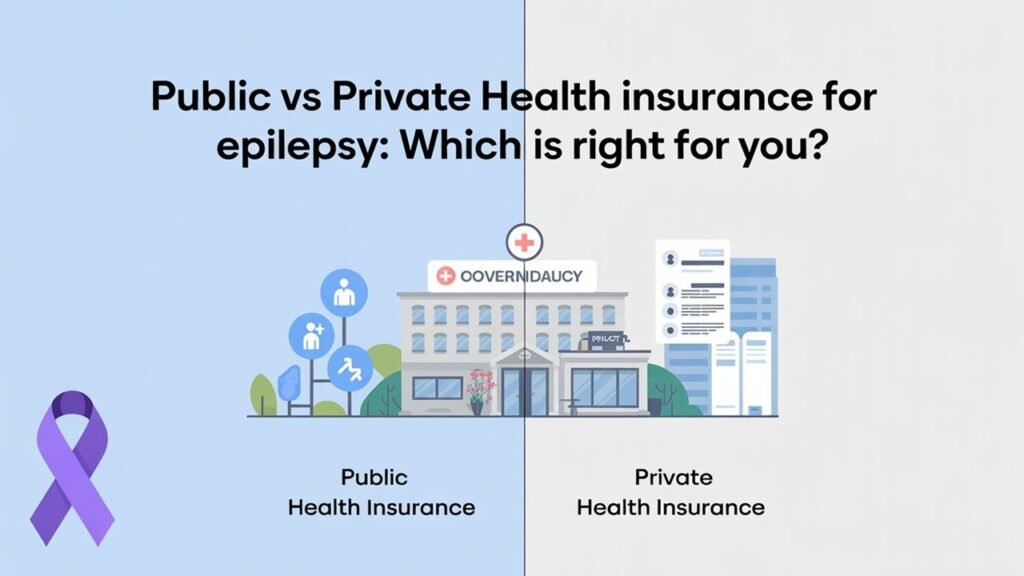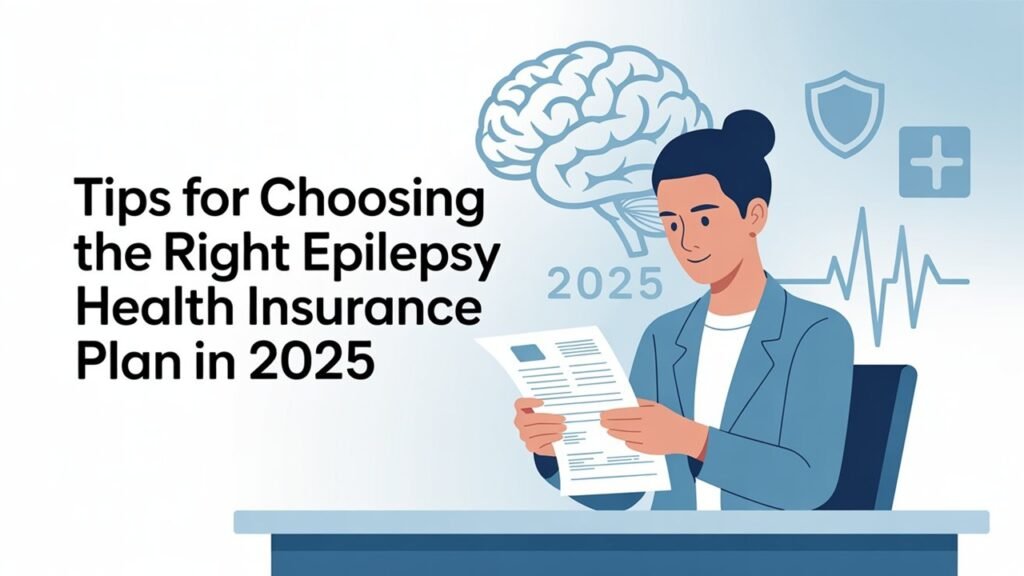Introduction—Why Health Insurance for Epilepsy Matters More Than Ever in 2025
With increasing drug prices, changing health insurance policies, and more complicated treatment choices, selecting the best health insurance for epilepsy is a crucial decision for individuals and their families.
Whether you’re newly diagnosed or have been managing epilepsy for years, the right health plan can be the difference between predictable care and financial ruin.
Key Reasons Why Epilepsy Coverage Is Crucial in 2025:
- High medication costs (including branded AEDs)
- Frequent neurology visits and diagnostic tests such as EEGs
- Unplanned ER visits and hospitalizations
- Pre-existing condition clauses in some plans lead to gaps in coverage
In this guide, we’ll cover everything from top-rated health plans for epilepsy patients to how insurance companies deal with epilepsy in 2025 and maximize your coverage.
What to Look for in the Best Health Insurance for Epilepsy
Finding the best health insurance for epilepsy in 2025 isn’t all about finding the lowest premium: it’s about finding a plan that gets what it means to have epilepsy and who will support your therapy every step of the way.
Key Coverage Needs for Epilepsy Patients
Try to identify the core issues listed below in your business plan evaluation stages.
- Prescription Drugs (Rx Coverage): Anti-seizure medications or anti-epileptic drugs (AEDs), such as Lamictal, Keppra, and Depakote, are required to be included in the plan, ideally at the generic level, to help patients keep costs low.
- Specialist Access: There should be no barriers to visiting a neurologist, and they should not require unnecessary referrals or out-of-network fees.
- Emergency Services: Seizures can result in non-preventable ER trips or ambulance usage; don’t get hosed with stupid copays for essential services.
- Diagnostics & Monitoring: This should encompass EEGs and MRIs, as well as, if relevant, wearable seizure detection devices.
Pre-existing Condition Clauses in 2025
Thanks to the Affordable Care Act (ACA), most insurers are prohibited from refusing to cover or limiting coverage of epilepsy as a pre-existing condition. However, always verify:
- No waiting periods for treatments related to epilepsy
- Full coverage and all follow-ups from Day 1
- No lifetime caps on care for epilepsy
Out-of-Pocket Costs & Deductibles: What’s Affordable?
Understand how each plan handles:
- Deductibles (threshold you must meet before coverage starts each year)
- Coinsurance and Copays on Prescriptions and Visits
- Maximum out-of-pocket limits are key to the treatment of chronic conditions such as epilepsy
🧠 Tip: Find a plan with low copays for prescriptions and tier 1 drug coverage to lower the cost of epilepsy medications

Top 5 Best Health Insurance Plans for Epilepsy in 2025
The best health insurance for epilepsy in 2025 is comprehensive coverage with affordable access to medications and dependable neurology support. Whether it’s private insurance, public programs, or digital-first health plans you’re looking for, here are the best epilepsy insurance options available for this year.
Blue Cross Blue Shield – Best for Nationwide Coverage
Why it stands out:
Blue Cross Blue Shield (BCBS) offers nationwide network availability, making it a top choice for epilepsy patients who require comprehensive options and national coverage. With robust prescription drug tiers and a rock-solid reputation, this one’s a no-brainer for families and professionals treating epilepsy.
Highlights:
- Covers most AEDs (anti-epileptic drugs)
- No or less strict referral to neurologists
- Emergency and diagnostic care is well-supported
Pros:
- Extensive national network
- ACA-compliant, no pre-existing condition exclusions
- Provides PPO plans for out-of-network choices
Cons:
- More expensive than some regional plans
- Neurology has limited telehealth in some states
2. UnitedHealthcare – Best for Specialist Access
Why it stands out:
UnitedHealthcare (UHC) stands out in terms of specialist availability, particularly in neurology and care for chronic conditions. Its technology has also helped epilepsy patients to schedule appointments and get prescriptions online.
Highlights:
- Broad neurology provider network
- Covers seizure monitoring equipment
- Integrated pharmacy services
Pros:
- Perfect for organizing complicated care schedules
- Simple digital scheduling and remote access tools
- Support for epilepsy-related devices
Cons:
- Some meds could need prior authorization
- It’s true that PPO plans might be more costly.
3. Cigna – Best for Epilepsy Prescription Coverage
Why it stands out:
If the cost of prescription is what you’re worried about most, Cigna is the best for formulary coverage of drugs for epilepsy. It offers several levels and opens enrollment, providing patients with access to drug price estimating tools that enable them to manage their finances effectively.
Highlights:
- The broad formulary covers newer AEDs
- Chronic condition management included
- 24/7 Health support lines
Pros:
- Excellent mail-order prescription service
- Good copay structure for generics
- Offers condition-specific support programs
Cons:
- Restricted number of plans in certain areas
- Not ideal for out-of-network care
4. Medicaid – Best for Low-Income Epilepsy Patients
Why it stands out:
Medicaid can provide the fullest package of epilepsy care to those who are eligible, at a nominal cost or no cost at all. Every state runs its program, but most cover access to neurologists, the cost of AEDs, and emergency services.
Highlights:
- Great for kids, seniors, and low-income adults
- Includes hospital stays, drugs, and follow-ups
- No exemptions for epilepsy as a pre-existing condition
Pros:
- Free or extremely low monthly fees
- Strong access to seizure medications
- Available in all 50 states
Cons:
- Plan features vary by state
- Not accepted by all specialists
5. Oscar Health – Best Digital-First Insurance for Epilepsy
Why it stands out:
Oscar Health combines 21st-century technology with the New York State of Health, one of the options available in New York State for managing epilepsy. Still, it will especially resonate with new adults or tech-savvy consumers managing a chronic condition. With virtual care, medication delivery, and mobile claims tracking, it’s a futuristic approach.
Highlights:
- Telehealth neurology consultations
- App-based care coordination
- Includes some wearable monitoring support
Pros:
- Intuitive app and customer service
- Affordable premiums for individual plans
- Streamlined digital experience
Cons:
- Limited to select states and cities
- May lack access to epilepsy specialists in rural areas
🔍 Quick Comparison Table
| Insurance Provider | RX Coverage | Specialist Access | Plan Type | Best For |
| BCBS | Excellent | Strong | PPO/HMO | Nationwide flexibility |
| UnitedHealthcare | Very Good | Best-in-class | PPO | Specialist-heavy needs |
| Cigna | Best for meds | Moderate | HMO/PPO | Affordable AEDs |
| Medicaid | Full (if eligible) | Strong | Varies | Low-income individuals |
| Oscar Health | Good | Moderate (telehealth) | EPO | Digital-first users |

Public vs Private Health Insurance for Epilepsy: Which Is Right for You?
Public vs private health insurance. When it comes to managing a chronic condition like epilepsy, the decision between public vs private health insurance can seem very daunting. These factors will influence which will be the “best” choice: income level, work status, home state of residence, and age, as well as whether you’re interested in finding affordable epilepsy insurance plans or if you’re willing to accept more flexibility and a higher premium.
Below, we break down all the plan types to help you make the most informed and cost-effective decision in 2025.
Medicare, Medicaid & Marketplace Plans
Public health insurance is indeed a lifeline for many Americans with epilepsy. Here’s how the primary options compare:
Medicaid (Low-Income Coverage)
- Low-income, disabled, and children only.
- Includes anti-epileptic drugs, seeing the neurologist, going to the ER, and for surgery in all but most states
- No pre-existing conditions are excluded, such as epilepsy
- Note: All 50 states have their own rules and benefits/services, so that details may vary.
✅ Pro Tip: If you make less than the federal poverty level, you should begin your hunt for a health plan by contacting your state’s Medicaid office.
Medicare (For Seniors & Disabled)
- Eligible at age 65+; some are eligible earlier if you’re on Social Security Disability Insurance (SSDI)
- Part B includes doctor visits; Part D includes prescriptions, which will consist of AED medication, for instance.
- You can also add a Medicare Advantage Plan for even more coverage and limits on out-of-pocket costs.
Marketplace Plans (ACA-Compliant)
- Offered via Healthcare.gov or state exchanges
- Epilepsy must be included on all plans as a pre-existing condition
- Provides basic health coverage, including specialists, visits to the emergency room, and prescription drugs
- Subsidies based on income
🔍 Natural sounding keywords included: epilepsy pre-existing condition insurance, epilepsy marketplace plan, Medicaid for epilepsy, and best insurance with no waiting period.
Private Plans Through Employers or Freelance Options
Private health insurance can also be a great choice if you’re after broader provider access, extra services, or if you want to package some wellness benefits. It’s particularly beneficial for people with epilepsy who work as employees or in self-employment.
Employer-Sponsored Health Insurance
- Commonly provides a PPO or HMO plan.
- Cheaper premiums since the employer pays into it.
- Comes with excellent drug and specialist coverage.
Freelancer or Self-Employed Plans
- Shopping may be necessary through the ACA marketplace or by purchasing a private PPO plan.
- A few insurers, such as Blue Shield and Cigna, have freelancer-friendly choices with reasonable access to epilepsy care
COBRA Coverage (Post-Employment)
- Enables you to keep your employer insurance for 18 to 36 months after leaving a job
- Great if you are transitioning between jobs and need continuous epilepsy care
💡 Watch Out: C.O.B.R.A. can be costly since you pay the full premium plus a 2 percent administrative fee.
High-Risk Pools & State Assistance Programs
While supplanted for the most part by ACA protections, some states still have programs in place to provide support like high-risk pools to people with chronic diseases such as epilepsy.
- Helpful: If you’ve been rejected for private insurance because of coverage lapses or other reasons.
- Commonly priced at a steep premium, but offer essential coverage to those who need it.
🧠 Quick Recap: Public vs Private – Which Is Best for Epilepsy?
| Insurance Type | Best For | Key Benefits | Considerations |
| Medicaid | Low-income, disabled | Free/low-cost, strong coverage | State-by-state variation |
| Medicare | Seniors, SSDI recipients | Full coverage with add-ons | Part D may not cover all AEDs |
| Marketplace (ACA) | Middle-income, freelancers | Subsidized plans, guaranteed coverage | Plan details vary |
| Employer Plans | Full-time workers | Strong network + low costs | Plan changes tied to job |
| COBRA | Between jobs | Continuity of care | High monthly cost |
| Private PPO/HMO | Freelancers, high-earners | Flexibility, nationwide coverage | Premium pricing |

Does Health Insurance Cover Epilepsy Medications & Devices in 2025?
If you are living with epilepsy, one of those questions is likely to be:
Does stomach sleep contribute to seizures, and should it be avoided?
The good news? In 2025, epilepsy care is universally supported in the majority of ACA-compliant, employer-sponsored, and Medicaid/Medicare plans. But the specifics and the price tags differ.
Here’s what to watch for to help ensure your health plan keeps pace with your medical situation.
Coverage for AEDs (Anti-Epileptic Drugs)
Anti-epileptic drugs (AEDs) are the foundation of seizure management, and they can be costly without adequate coverage.
Most insurers in 2025 cover:
- Generic AEDs (eg, levetiracetam, carbamazepine, lamotrigine)
- Prior Authorisation Brand-name drugs (example: Vimpat, Briviact)
- Extended-release versions and liquid formulations
Key coverage terms to review:
- Tier of a drug: If a drug has a lower tier, you generally pay a lower copay.
- Preauthorization: Certain AEDs may require preapproval before coverage is provided.
- Quantity limits: Monthly limits may apply to the needed dosage for patients.
Epilepsy Monitoring Devices & Surgical Options
Epilepsy care today extends well beyond pills. Some patients may need to use wearable devices, neurostimulation implants, or undergo surgery. But what’s covered?
Commonly Covered Devices in 2025:
- EEGs (Electroencephalograms) – Are payable for diagnostic purposes.
- Durable medical equipment you need to go about daily life (e.g., seizure detector that you wear, like Empatica or SmartWatch) – May be associated costs may be partially reimbursed by insurance.
- Responsive Neurostimulation Devices (RNS) -Coverage of RNS will vary with the carrier and state political jurisdiction.
- Vagus Nerve Stimulators (VNS) – Most employer and public plans cover with authorization.
Surgical Interventions:
If medications and devices fail, some patients may be candidates for epilepsy surgery (e.g., resective surgery). Most high-tier plans and public insurance options do carry these, however, typically after other choices have been tried.
Tips to Ensure Coverage:
- Get a referral from your neurologist
- Ensure the hospital and surgical team are in-network
- Have your provider help you file pre-authorization paperwork
⚠️Care: Be sure to consult your plan’s Summary of Benefits and Coverage (SBC) to verify coverage for specific devices or surgeries.
✅ Quick Coverage Snapshot
| Treatment Type | Typically Covered? | Notes |
| Generic AEDs | ✔️ Yes | Lowest out-of-pocket cost |
| Brand-name AEDs | ✔️ With prior auth | May fall under higher tier |
| Wearable Detectors | ⚠️ Partial | Coverage varies widely |
| EEGs & Monitoring Tests | ✔️ Yes | Included under diagnostics |
| Neurostimulation Devices | ✔️ With limits | Often requires neurologist referral |
| Epilepsy Surgery | ✔️ With referral | High-tier or public plans cover after trials |

How to Apply for Health Insurance if You Have Epilepsy
Applying for health insurance when you have epilepsy does not have to be a head-scratcher, but it does take strategy. Whether you’re navigating the ACA exchange, applying for Medicaid, or considering private PPO plans, timing, documented need, and awareness of pre-existing condition protections are even more critical in 2025.
Let’s break it down.
Enrollment Windows, Special Circumstances & Pre-Existing Conditions
Nearly all insurance plans, including those with the best health insurance for epilepsy, adhere to specific enrollment dates. Skipping them can leave you without coverage for many months, especially if you aren’t eligible for a Special Enrollment Period (SEP).
Key Enrollment Periods in 2025:
- Marketplace Open Enrollment: Nov 1 to Jan 15 in most states.
- Medicaid/CHIP: Year-round enrollment.
- Employer Coverage: Generally within 30-60 days of being hired, or during open enrollment each year.
- Medicare: The period starts 3 months before your 65th birthday and ends 7 months later.
Pre-Existing Conditions:
Epilepsy is a pre-existing condition covered under ACA protections. That means:
- Epilogue: No denying based on your past epilepsy
- No seizure or neuro status paying extra in premium here
- Entities where there are no waiting periods for epilepsy related services on compliant plans
Avoiding Gaps in Coverage
If you miss an open enrollment period or lose your job unexpectedly, you can be left without insurance coverage and exposed to high medical costs. Here’s how to stay off the cracks:
Options if You Lose Coverage Mid-Year:
- Special Enrollment Period (SEP): Triggered by qualifying events such as job loss, marriage, or move with residence change
- COBRA Coverage: Initial continuation of your previous employer coverage for up to 18 months
- Short-Term Plans: Few benefits, but may help out on a gap (⚠️ commonly exclude treatment for epilepsy)
Tips for Continuous Coverage:
- Mark Your Open Enrollment Deadlines. If available, set reminders for your open enrollment days.
- Second, apply for Medicaid immediately if income stops
- If you plan to move when transitioning, inquire with your current provider about a grace period or the option to make payments.
📝 Documents You’ll Likely Need When Applying:
- Documentation of income (W-2s, tax returns, pay stubs)
- Medical record (for Medicare disability-based entitlement)
- Social Security or immigration status (for Medicaid or the ACA)
- You’re prescription (if you want a plan comparison tool, not morning after)
💡 SPARKLE Tip: Equip yourself with resources like Healthcare. Gov, the Epilepsy Foundation insurance guides, or consult with a licensed insurance broker to determine the best option for your location and treatment needs.

Tips for Choosing the Right Epilepsy Health Insurance Plan in 2025
The best health insurance for epilepsy is not just about the cost of premiums; it’s about the quality of the coverage for neurologists, anti-seizure drugs, and a lot of other types of care and treatments.
Here’s how to make sure you know just what to look for when you choose the best health insurance plans for epilepsy in 2025 — regardless of whether you’re shopping on the ACA marketplace, in the private market, or using Medicaid.
🔍 Look Beyond the Monthly Premium
A low monthly price isn’t much use if your plan doesn’t cover epilepsy care well.
Focus on Total Cost of Care:
- Deductibles: What do you pay before the coverage begins?
- Copays/Coinsurance: What is your share for each visit, test, or prescription?
- Out-of-Pocket Maximum: Once you reach this threshold, the plan covers 100% of all covered services.
📌 Example: The plan with a $50 premium and $9,000 deductible may be more expensive than one with a $150 premium and $2,000 cap.
✅ Ensure Neurologist & Medication Coverage
Some plans do not cover antiepileptic drugs (AEDs) or permit specialists to be seen without a referral.
Check These Details:
- Is your neurologist in-network?
- Is Keppra, Lamictal, or Vimpat on the formulary?
- Does the plan require pre-authorization for EEGs, MRIs, or epilepsy surgery?
💊 SPARKLE Pro Tip: Before signing up, check if a medication is covered in your insurer’s online formulary or have your pharmacy run a coverage check.
🧭 Use Digital Tools to Compare Plans
Technology also makes comparison more convenient than ever, a narcissist’s dream, a sociologist’s gold. Filter by on trusted platforms:
- Coverage of chronic conditions
- Drug benefits
- Hospital networks
- Epilepsy- specific ratings (when present)
Top Tools for 2025:
- HealthCare.gov
- Policygenius
- eHealthInsurance
- State-based exchanges (e.g., Covered California, NY State of Health)
💡 Final Considerations Before You Enroll
- Contact your health plan to verify that epilepsy treatment is covered, and always check with the insurer directly.
- Check twice for seizure emergencies and hospital trips.
- Inquire about telehealth neurology visits, especially in rural areas.
- If your epilepsy is interfering with employment, look into disability-based Medicare choices.
🔐 Ensure the plan is A.C.A.-compliant so you’re protected from discrimination and coverage gaps.

Real-Life Case Studies: Finding Affordable Health Insurance with Epilepsy
Sometimes, the best advice comes from someone who has been there. Here are real-life tales from fellow epilepsy warriors on how to find, and not give up on, the best health insurance plans when confronted with job loss, low income, or pre-existing condition fears.
These case histories supply concrete, relatable strategies and illustrate how to turn frustration into empowerment, whether dealing with Marketplace plans, Medicaid, or private insurers.
👩⚕️ Case 1: Single Freelancer Navigates Marketplace for Neurologist Coverage
Profile:
- Name: Lisa
- Age: 33
- Occupation: Freelance designer
- Condition: Focal epilepsy
- Problem: “My daughter’s first seizure occurred when she was six days old.
- Location: New York
Solution:
Lisa relied on the New York State of Health Exchange to trace a Silver-tier plan with:
- $15 copays for neurology visits
- $10/month prescription coverage for Keppra
- Zero referrals required for specialists
🎯 Key takeaway: Silver plans generally balance a lower monthly cost and relatively low out-of-pocket for fundamental epilepsy care.
👨👩👧 Case 2: Family of Three Finds Affordable Plan Through Medicaid Expansion
Profile:
- Names: Jason & Emily Parents of: 8 year old Mia (diagnosed with CAE)
- Household Income: Less than 138% of the FPL
- Location: Ohio
Solution:
And thanks to Medicaid expansion, Mia was eligible for full coverage for pediatric epilepsy treatment, including:
- Regular EEG monitoring
- Breakthrough seizures in the emergency room
- Full coverage of Ethosuximide
💡 Pro Tip: Children with epilepsy may be eligible for CHIP or full Medicaid, even if parents are not if you live in a Medicaid expansion state.
👩💼 Case 3: Early Retiree Uses ACA Subsidy for Affordable Coverage
Profile:
- Name: Robert, 59, early retiree with tonic-clonic seizures
- Income: $24,000 annually
- Issue: High premiums and access to drugs
- Location: Texas (non-expansion state)
Solution:
Robert used the ACA HealthCare.Gov portal and had applied for premium tax credits. He signed up for a Bronze plan with a Health Savings Account (HSA) and:
- Received a $300/month subsidy
- Paid $35 to cover the cost of Depakote ER per month
🧾 The takeaway: Even in non-expansion states, premium subsidies can dramatically cut costs for lower-income people with epilepsy.
🌍 Case 4: Immigrant Family Secures Short-Term Coverage with Limited Options
Profile:
- Names: Fatima and Ahmed. Quick Brunch: Recent immigrants, with temporary work visas
- Problem: No ACA marketplace access; 12-year-old son has Lennox-Gastaut syndrome
- Location: California
Solution:
They got a short-term private insurance plan (through eHealth) and combined it with a nonprofit prescription assistance program. While not ideal long-term, it:
- Covered emergency hospitalization
- Provided access to neurology consultations
- Provided bridge coverage until employer insurance kicked in
🛑 Warning: Many short-term plans do not meet the Affordable Care Act’s coverage requirements, and there could be severe and costly limitations for people with epilepsy.

Conclusion: Take Control of Your Health and Coverage Today
When we’re talking about the best health insurance for epilepsy in 2025, we’re not just talking about premiums — but protection, access, and peace of mind.
Whether it’s keeping your daily seizures under control, caring for a loved one with epilepsy, or keeping up with a recent diagnosis, the right insurance can significantly enhance your quality of life. A smart policy would save thousands a year, hundreds of thousands over the course of a lifetime — and, in some instances, lives.
Frequently Asked Questions (FAQs)
❓ What Is the Best Health Insurance for Epilepsy in 2025?
There is no “one-size fits all” plan for everyone — but for the most part, the best health insurance for epilepsy includes:
Neurology & specialist care coverage
Low-cost anti-seizure medication tiers
EEG, MRIs, access to emergency care
❓ Is Epilepsy Considered a Pre-Existing Condition?
Yes. My mother is listed as pre-existing (the epilepsy). But insurance companies can’t deny you coverage or charge you more for it, thanks to the Affordable Care Act (ACA).
❓ Can You Get Health Insurance if You’re Unemployed and Have Epilepsy?
Yes. You may qualify for:
Medicaid (if your state adopted the expansion)
Marketplace subsidies via HealthCare. gov
Your ex-employer’s COBRA plan (expensive but fast)
❓ What Medications Are Typically Covered for Epilepsy?
Many large plans cover Tier 1 or Tier 2 AED (Anti-Epileptic Drugs), including:
Keppra (levetiracetam)
Lamictal (lamotrigine)
Depakote (valproic acid)
Topamax (topiramate)
As always, be sure to check the plan’s formulary to ensure your prescription is covered at an affordable price.
❓ What If My Plan Doesn’t Cover My Seizure Medications?
But preventive medicine may not cover all medications, or costs may be prohibitive:
Have your doctor submit a prior authorization
Appeal the rejected claim from your insurer
Utilize patient assistance programs (PAPs), like NeedyMeds or RxAssist.
Search for generic solutions or discount pharmacies.
❓ Can Children with Epilepsy Qualify for Special Health Programs?
Yes! Children may qualify for:
CHIP (Children’s Health Insurance Program)
Medicaid if household income is modest
School-based health services (by IEP or 504 plan)
❓ Are There Epilepsy-Specific Health Insurance Plans?
Not exactly — there are no insurance plans specifically for epilepsy. However, some insurers offer:
Chronic condition management programs
Epilepsy-focused case managers
Tailored formularies for seizure medications
❓ How Much Does Health Insurance for Epilepsy Cost in 2025?
Average monthly premium (with subsidies):
Bronze plan: $60–$100/month
Silver plan: $120–$200/month
Gold plan: $200–$350/month
Out-of-pocket maximums are still relevant — without coverage, the cost of managing epilepsy can be more than $10,000 a year.


![Best Life Insurance for Police Officers [Low Rates + Full Coverage]](https://finverrahq.com/wp-content/uploads/2025/07/Best-Life-Insurance-for-Police-Officers-Low-Rates-Full-Coverage-150x150.jpeg)


Pingback: Why IUL Is a Bad Investment in 2025 | Best Guideline
Pingback: Best Affordable Health Insurance for Small Nonprofits [2025]